Too much sun can do more than turn your skin red or brown—it can actually make you sick.
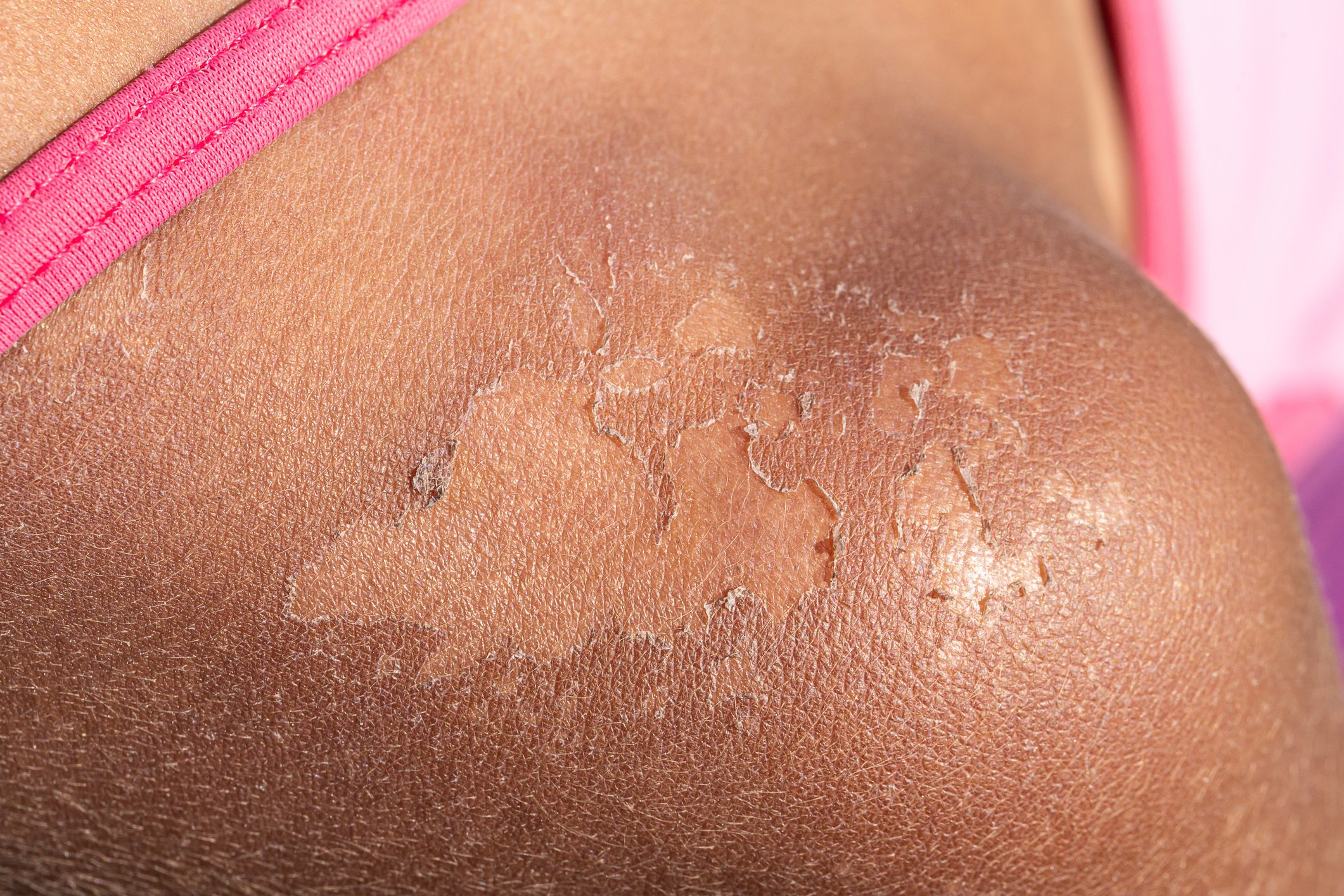
11 Signs Your Sunburn Is Actually Sun Poisoning, According to Expert Dermatologists

“Sun poisoning is an extreme version of a sunburn,” explains Farah Moustafa, MD, FAAD, dermatologist and Director of Laser and Cosmetics at Tufts Medical Center. She says it starts with red, painful skin—like a regular sunburn—but sun poisoning symptoms can get serious, quickly. “This extreme version of sunburn needs medical attention.”
While one in three Americans report they get a sunburn each year, about 33,000 wind up needing medical treatment for severe sun poisoning symptoms, according to the National Cancer Institute. Below, doctors explain how to tell if your sunburn is something more serious—and when it’s time to seek treatment.
What is sun poisoning?
“I always tell my patients that sun poisoning is essentially an extreme sunburn, but with systemic symptoms that go beyond just red, painful skin,” says Hannah Kopelman, MD, a dermatologist at Kopelman Aesthetic Surgery and co-founder of DermOnDemand. In a nutshell, you’re not actually being poisoned from sunlight, but experience a severe reaction to the effects of UV radiation.
“A bad sunburn will cause redness, tenderness, and possibly blistering,” she explains. “But sun poisoning takes it further.” The symptoms of sun poisoning might mimic an allergic reaction or make you feel like you’ve come down with the flu, for instance.
Sun poisoning can affect anyone. But some people are at a higher risk, such as those:
- With fair skin
- Who have a family history of skin cancer
- Who live near the equator (or any area with a high UV index)
- Taking certain medications, including antibiotics or some topical creams (such as retinoids)
- With certain chronic conditions, such as autoimmune diseases like rheumatoid arthritis, psoriasis, or lupus
The Cleveland Clinic notes that what causes sun poisoning isn’t clearly understood—and this intense sunburn can affect people differently.
However, treatment is essential. Sun poisoning can become very serious without proper care, leading to dehydration, heat exhaustion, and even potential organ damage, according to the Journal of Dermatologic Research and Therapy.
Sun poisoning symptoms
“[Sun poisoning] can basically feel like a really bad cold or flu with full body symptoms,” Dr. Moustafa explains. While you might notice a red, painful sunburn right away, symptoms of sun poisoning can take a few hours to appear—or even a few days.
Depending on the severity of the sun poisoning, you may experience:
- Nausea
- Light-headedness
- Fever
- Chills
- Vomiting
- Dehydration
- Headache
And that’s in addition to severe redness, pain, tenderness, and possible blistering of the skin itself, says Dr. Kopelman.
How to tell if you have sun poisoning
A sunburn is actually a radiation burn caused by the sun’s UV (ultraviolet) rays. Per the MD Anderson Cancer Center, our skin cells can manage some level of UV exposure on their own. But when it’s too much, those cells die off—and in response, our body sends blood and immune cells to the skin to help repair the damage. This is what causes the redness, swelling, and other symptoms typical of a sunburn.
On the other hand, “Sun poisoning isn’t just skin-deep—it triggers an inflammatory response throughout the body,” Dr. Kopelman explains. “The body recognizes the intense UV damage as injury, and the immune system reacts by releasing inflammatory chemicals, much like it would if you had an infection.”
That’s why the symptoms of sun poisoning go beyond the skin, too.
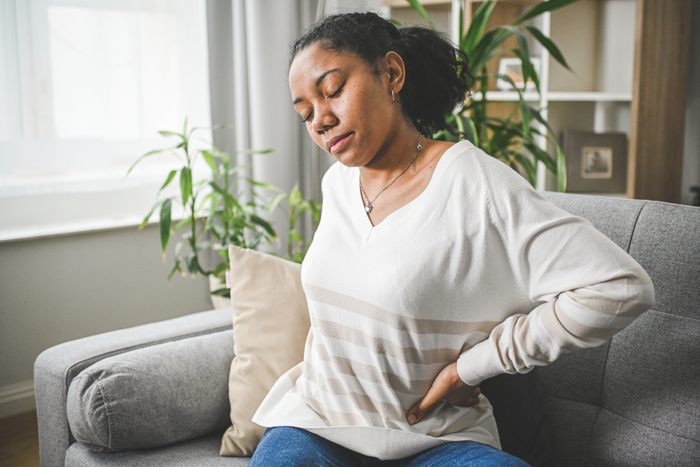
1. You feel like you have the flu
Summer isn’t exactly flu season, so if you feel achy or have other flu-like symptoms after a long day in the sun, it’s a sign you may be dealing with sun poisoning rather than just a typical sunburn.
“When the skin is damaged by UV rays, it releases chemicals that basically turn on the immune system and make you feel terrible, like you’ve got the flu,” says John Anthony, MD, FAAD, a dermatologist at the Cleveland Clinic in Cleveland, Ohio. This inflammatory reaction can trigger flu-like symptoms ranging from fever and chills to fatigue, nausea, vomiting, and body aches, Dr. Kopelman adds.
“If you’re feeling body aches, they can be widespread, but I often hear from patients that they feel particularly sore in areas where they got the worst sunburn,” she explains.
Remember: Sun poisoning isn’t technically poisoning—it’s a lay term for a severe sunburn that has systemic (body-wide) effects. So, when you turn the corner from uncomfortable redness to a deep rouge so severe it activates an immune response that makes you feel sick, that’s a sign you’ve had way too much sun.
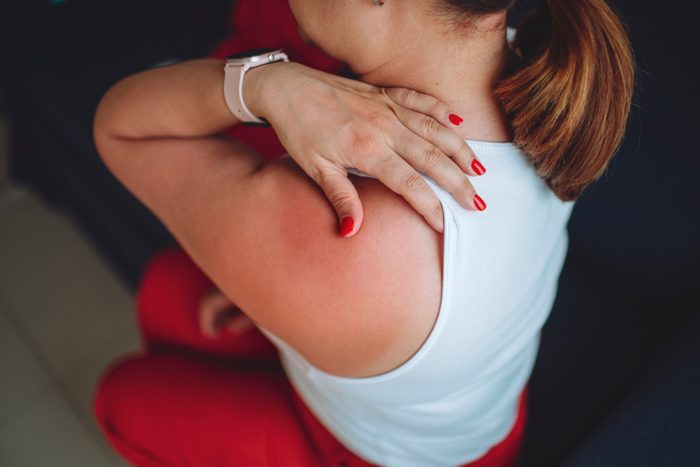
2. Your skin prickles
An ordinary sunburn is far from comfortable to touch, but sun poisoning even more so. If your body is covered in a prickly sensation or you want to scream every time a hand or shirt brushes against your skin, it could be a sign your sunburn is on the very severe side.
Apply soothing aloe, take a cool shower, use cold compresses, or pop an ibuprofen to relieve the pain. And don’t forget to check out what dermatologists would do if they were sunburned.
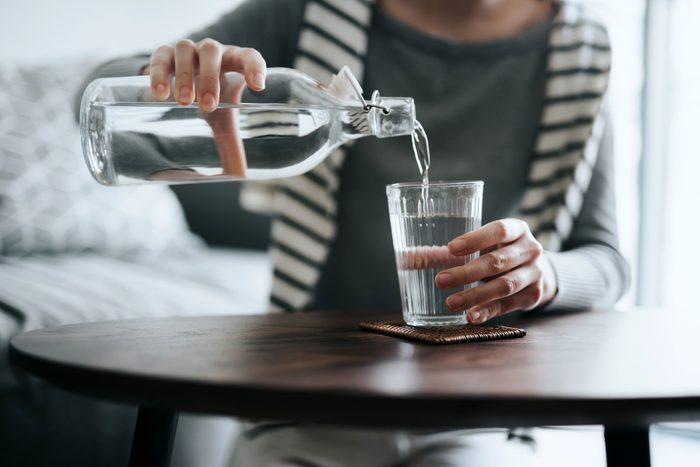
3. You’re extremely thirsty
Sun poisoning can cause extreme dehydration, Dr. Moustafa says. “The skin becomes very inflamed and draws in fluid from other parts of your body,” she explains. This means less water is circulating in your blood—and to vital organs—leading to dehydration.
Thirst is often an early sign of dehydration, but other symptoms include:
- Dark-colored urine
- Not urinating
- Dry skin, especially in the mouth and lips
- Feeling faint or unusually tired
- Lightheadedness, headaches, or dizziness
But because dehydration can lower your blood pressure (since there’s less fluid circulating), it can lead to more serious symptoms like a racing heart or rapid breathing. In severe cases, this drop in blood pressure prevents your organs from getting enough oxygen-rich blood, which can lead to shock—and this is life-threatening.
In mild cases of dehydration—like if you’re just feeling thirsty—drinking water can help, Dr. Moustafa says. But in cases of sun poisoning, “This is often not enough, and IV hydration done in a clinical setting is required to protect vital organs.”
It’s important to take in electrolytes after extreme sun exposure as well. “Salt is also lost in sweat, and drinking lots of water to correct hydration without replacing electrolytes can also be problematic,” she says.
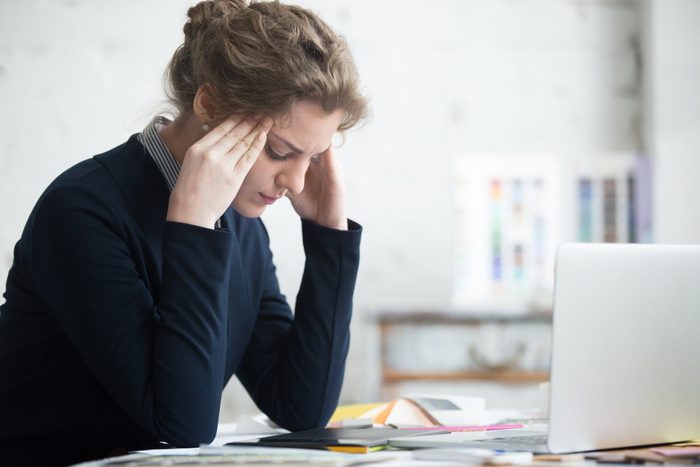
4. You feel dizzy or have a headache
The severe fluid loss that results from sun poisoning can cause symptoms of dizziness, fainting, headaches, and confusion, Dr. Moustafa says.
As your body redirects fluids to your sunburned skin, this lowers your total blood volume. In turn, your blood pressure can drop—and this impacts how much oxygenated blood reaches your brain. That’s why you might feel a bit disoriented, dizzy, or have a headache when dealing with an intense sunburn.
Sunburns and the associated dehydration can also cause an electrolyte imbalance, per the Cleveland Clinic. Because electrolytes are responsible for functions like blood pressure control, fluid balance, and nerve function, when they’re depleted, you may feel confused, irritable, dizzy, or have a headache.
Other signs of an electrolyte imbalance can include:
- Diarrhea or constipation
- Fatigue
- Irregular heartbeat or racing heart
- Muscle cramps or weakness
- Nausea or vomiting
- Tingling or numbness—especially in the fingers and toes
If your head feels off, you feel nauseous, or you have a headache, then you should drink plenty of fluids and lay down to rest. Also, make sure you’re avoiding these things you should never do after getting a sunburn.
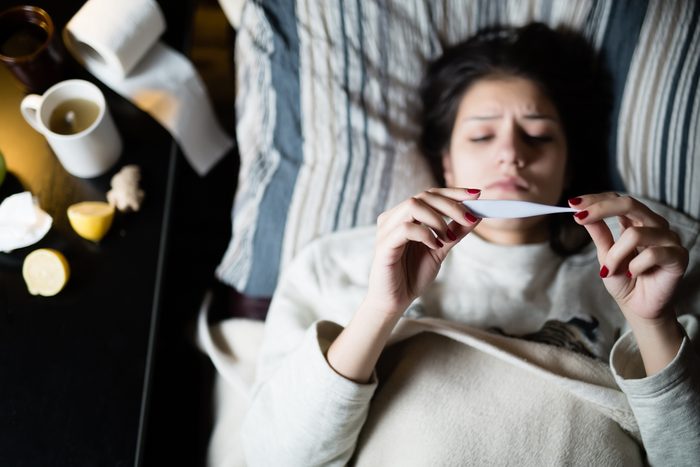
5. You have a fever
Your body responds to sun poisoning similar to how it responds to an infection—by activating a strong immune system response. A fever is often a part of this response because when your body temperature is higher, it boosts the performance of your immune cells while making it harder for bacteria or viruses to cause harm, according to research from Evolution, Medicine, & Public Health.
While there aren’t pathogens to fight off when you have sun poisoning, a fever indicates that your body is working hard to try and heal. But it’s important to keep an eye on how high your temperature rises. “Usually a fever of 102 to 103 [degrees Fahrenheit] is a cause for concern and requires immediate attention,” Dr. Moustafa says. This is especially true if you also feel noticeably ill and have chills, Dr. Anthony adds.
“Treatment is usually with hydration, cold compresses, and anti-pyrectics like Tylenol,” says Dr. Moustafa. But if your fever is running especially high—or won’t go away—check in with your doctor for additional care.
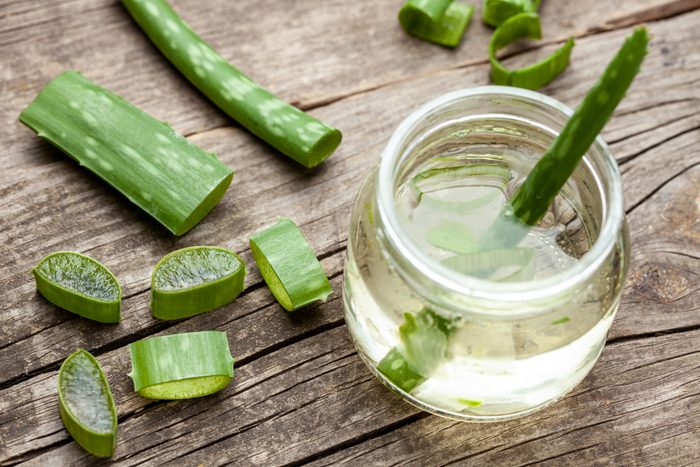
6. Your skin blisters
Blistering is also a sun poisoning symptom. Not only do blisters mean you’ll likely be in some serious pain until they heal, but you’re also at risk for infection if germs and bacteria get into open wounds. So, don’t create any open wounds by popping, picking at, or scratching the blisters.
Apply aloe, which Dr. Anthony says he uses to treat severe burns; take an anti-inflammatory to combat the physical pain; and stay out of the sun until they’ve fully healed.
Sun poisoning blisters can occur anywhere that’s been exposed to the sun’s UV rays—and this can include spots we often forget to protect with sunscreen or UV-resistant clothing, such as the lips, scalp, ears, hands, and feet.
“If someone has severe blistering on the hands or face, you should get looked at by a doctor, just in case,” he says. Also keep an eye out for swelling, fluid-filled blisters, spreading redness around the blistered area, or worsening pain—these could be signs of infection that need medical treatment.
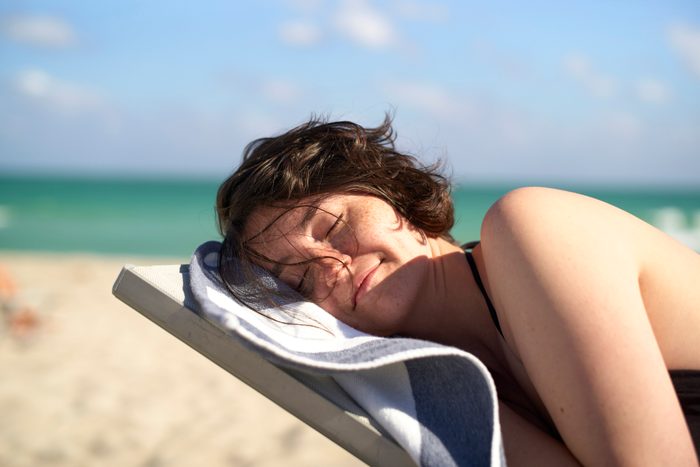
7. You fell asleep in the sun
“I usually see sun poisoning in people who fall asleep in the sun and then get burned terribly,” says Dr. Anthony.
The amount of time it takes for a sunburn to reach its maximum burn or for you to feel whole-body effects varies. It could happen as soon as you get inside or take over while you’re sleeping that night. So, if you’ve accidentally spent an entire afternoon catching rays on unprotected skin, take precautions by upping your fluid intake and applying aloe, even before you start experiencing any sun poisoning symptoms.
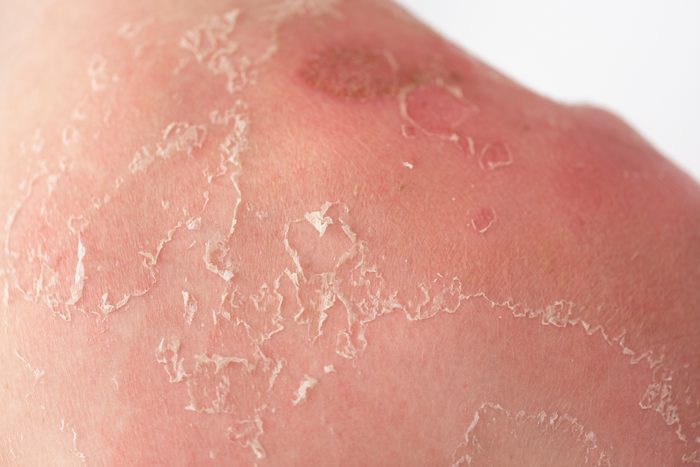
8. Your skin is peeling…a lot
Skin peeling is a sign that your body is shedding skin cells killed or damaged by UV rays—and the more severe the sunburn, the more peeling you can expect. It’s a natural part of the healing process that usually begins a few days after sun exposure, once the skin’s inflammation and swelling has gone down.
But like skin blisters, the experts emphasize you shouldn’t pick at peeling skin (or try to exfoliate it away). Even though it’s dead, this flaky skin is protecting the new, fresh skin cells beneath—and picking it off can slow healing or put you at risk of infection.
The Cleveland Clinic says that you can try and manage skin peeling by:
- Adding more moisture to your skin with aloe vera
- Drinking extra water to boost skin hydration
- Avoiding hot showers—hot water can dry your skin out even more
- Not using oil- or petroleum-based lotions (until the peeling and swelling is gone), as these products can trap heat in the skin
- Wearing loose, soft fabrics to avoid further skin irritation
- Taking over-the-counter anti-inflammatory meds like ibuprofen to reduce pain or discomfort
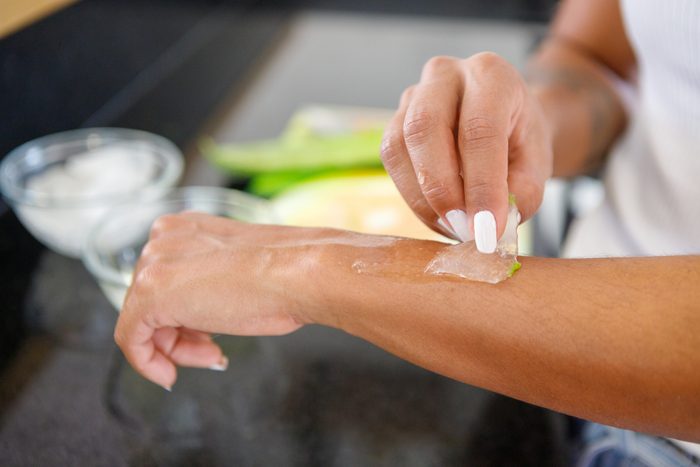
9. You have a rash on your body
A sun poisoning rash is usually an intense red, inflamed, and itchy eruption on the skin, sometimes with small bumps or blisters. “This happens because the skin is severely inflamed from excessive UV exposure, which damages the top layers of skin and triggers an immune response,” Dr. Kopelman explains. “It can feel hot, swollen, and extremely tender to the touch.”
In milder cases, you can treat the rash at home with cool compresses, aloe vera, and over-the-counter hydrocortisone to calm inflammation, she says. “If there are blisters, I always advise patients not to pop them—doing so increases the risk of infection and slows down healing.”
Dr. Kopelman says that most rashes from sun poisoning improve within a few days to a week, but if they worsen, spread, or show signs of infection—like oozing or increased pain—it’s time to see a doctor.
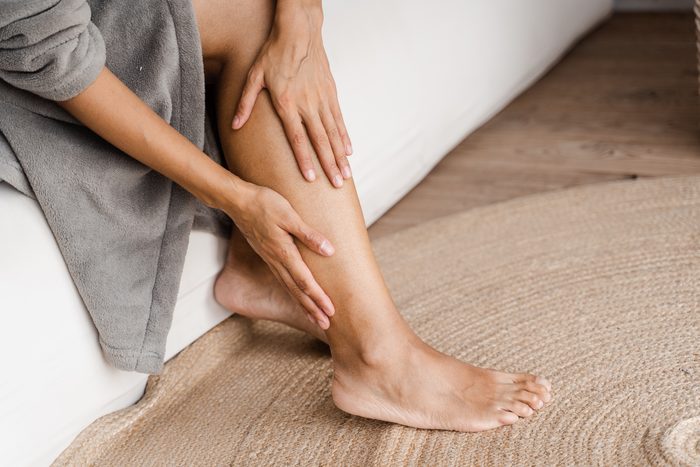
10. Your body is swollen
“Swelling happens because of the intense inflammation and fluid retention that sun poisoning causes,” Dr. Kopelman explains. When the skin is severely burned, blood vessels become leaky, she says—and this leads to localized swelling, especially in the face, hands, and feet.
But sometimes, people also experience swollen lymph nodes—located in areas including the neck, armpits, chest, belly, and groin—as the immune system works to repair the damage. “I always tell patients to keep the affected areas elevated if possible, drink plenty of fluids, and apply cool compresses to bring down the swelling,” she says.
“If swelling is extreme—especially in the throat or around the eyes—it could indicate a more serious reaction and requires immediate medical attention.”
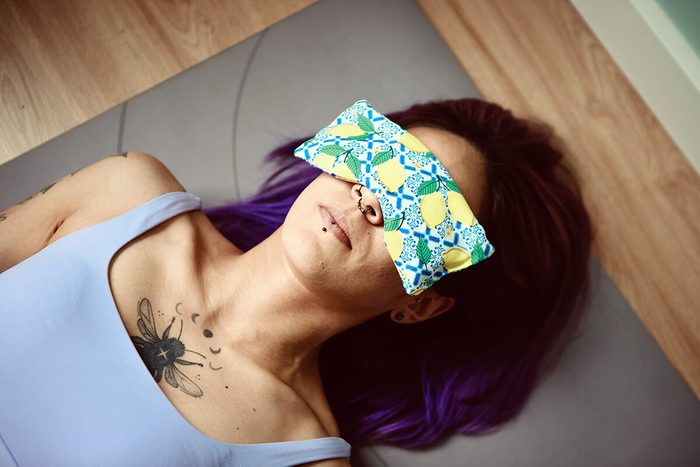
11. Your eyes hurt
The eyes are incredibly sensitive to UV damage, Dr. Kopelman says. “Prolonged sun exposure can cause a condition called photokeratitis—essentially a sunburn on the cornea,” she explains. “This can lead to pain, redness, light sensitivity, and even a gritty sensation, like there’s sand in the eyes.”
If you experience eye pain after sun exposure, she recommends staying out of bright light, using artificial tears to keep your eyes lubricated, and applying a cool, damp cloth over closed eyelids.
“In more severe cases, wearing sunglasses indoors and resting the eyes in a dark room can help with discomfort,” she says. “If vision is affected or the pain is severe, an eye doctor should be consulted.”
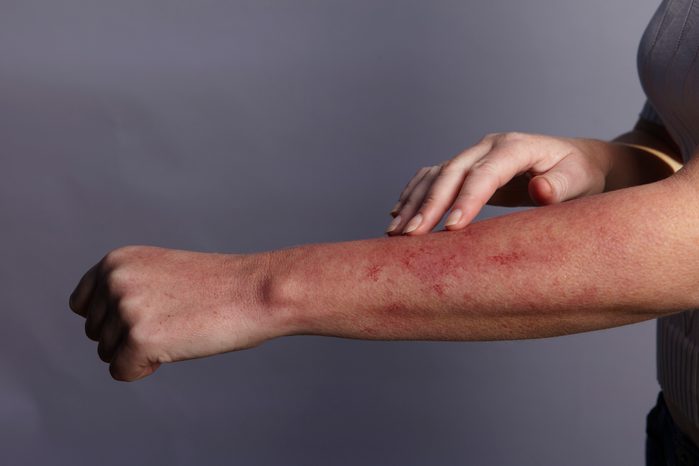
Heat rash vs. sun poisoning
“Heat rash can sometimes get confused with sun poisoning, but there are key differences,” Dr. Kopelman says.
Heat rash is caused by sweat getting trapped under the skin and appears as tiny, red bumps—usually in the folds of the skin—rather than the widespread inflammation associated with sun poisoning, she says.

Sunstroke vs. sun poisoning
“Sunstroke is better referred to as heat stroke as it is not always caused by the sun,” Dr. Moustafa explains. “It can be a result of any activity that results in the body not being able to regulate body temperature—and it’s a medical emergency.”
She says that symptoms of heat stroke and sun poisoning are often similar. However, the body overheating due to heat stroke generally causes different changes to your skin color, making it more flushed or paler than usual, not burnt.
Heat stroke is also associated with severe physical and neurological symptoms, like confusion, a rapid heartbeat, and fainting, Dr. Kopelman adds.
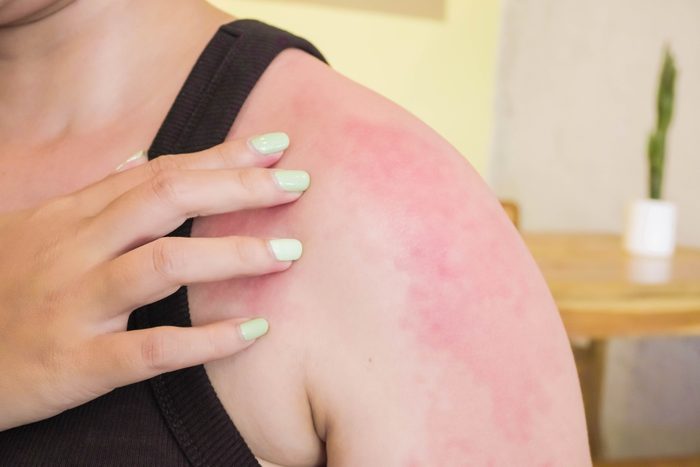
What’s a fast way to get rid of sun poisoning?
“Unfortunately, there’s no instant fix for sun poisoning,” Dr. Kopelman says. “But there are ways to manage symptoms and support the healing process.” With proper care, most cases of sun poisoning resolve in a few days to a week.
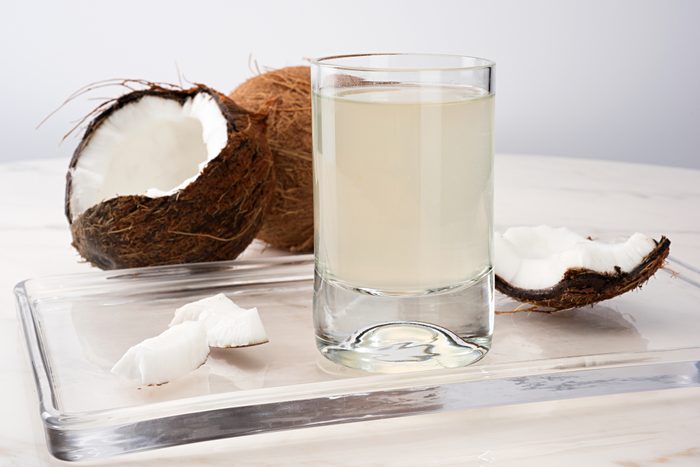
How to treat sun poisoning
“First and foremost, I tell patients to get out of the sun immediately and start hydrating—water, electrolyte drinks, and even coconut water can help replenish fluids,” Dr. Kopelman says.
Once indoors and hydrating, she offers other ways to ease sun poisoning symptoms and support your body’s healing:
- Take cool showers or use cool compresses to soothe the skin.
- Apply aloe vera or moisturizer (without any fragrance, oil, or petroleum) to help reduce peeling and inflammation.
- Take over-the-counter pain relievers like ibuprofen to help with inflammation and discomfort.
- Wear loose, breathable clothing while the skin heals.
- Use over-the-counter hydrocortisone cream to soothe rashes and swelling.
- Importantly, avoid any further sun exposure.
- Rest as much as possible.
Plus, here are things experts say you shouldn’t do after getting a sunburn.
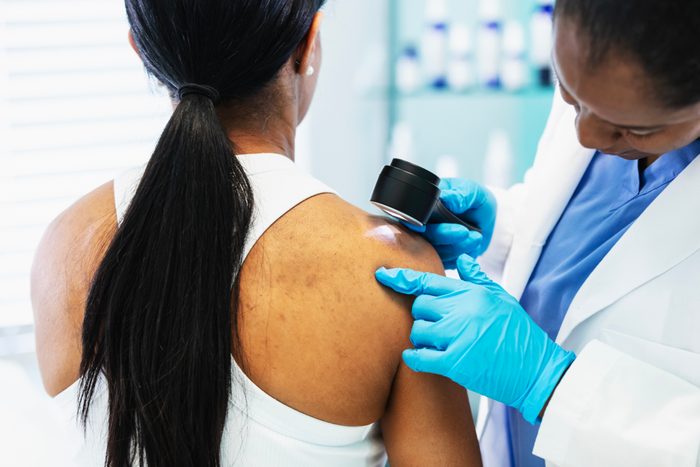
When to see a doctor
While sun poisoning should resolve within a week, “if symptoms worsen—such as increasing pain, spreading redness, or a fever that won’t go away—it’s time to seek medical attention,” Dr. Kopelman says.
But there are some signs that you should see a doctor sooner. “If nausea or dizziness are severe, it may be a sign of dehydration, and IV fluids may be needed,” she says. “Certainly, if someone feels faint or is having altered mental status, then they should immediately be seen by a medical professional,” Dr. Moustafa adds.
Dr. Moustafa also notes that if at-home treatments are not working, it’s best to see your doctor sooner rather than later. This could mean that you’re unable to get hydrated in spite of drinking lots of fluids, over-the-counter meds aren’t relieving pain and discomfort, or cool compresses don’t help soothe your skin.
“The most important treatment [a doctor] will do is correcting dehydration and electrolyte loss, which can be life-threatening if not managed promptly,” Dr. Moustafa says. “They can also monitor effects on other organs through bloodwork.”
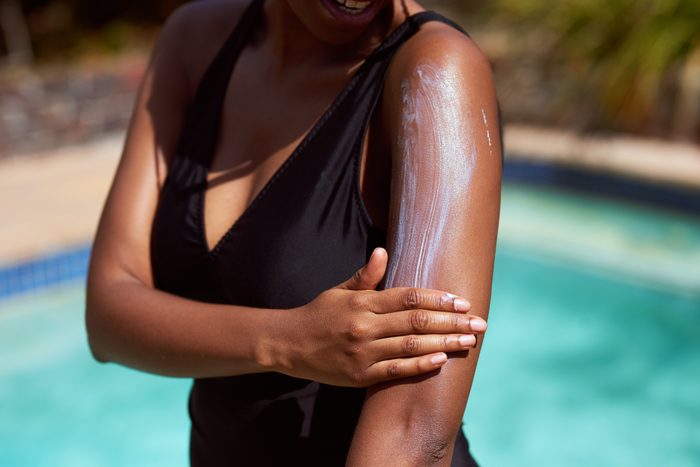
How to avoid getting sun poisoning
To protect yourself against sun poisoning, “The most important thing to do is avoid extended periods in the sun outdoors between 10 a.m. and 4 p.m. when the sun’s UV rays are the strongest,” Dr. Moustafa says. You can also check the day’s UV index—which is available through most weather apps on your phone—when planning to be outdoors, and try to minimize time in the sun during those peak hours.
“While outside, proper hydration, SPF application of 30 or higher with frequent re-application, and staying adequately hydrated [after sun exposure] offer the best protection in preventing sun poisoning.”
For daily wellness updates, subscribe to The Healthy by Reader’s Digest newsletter and follow The Healthy on Facebook and Instagram. Keep reading:





















